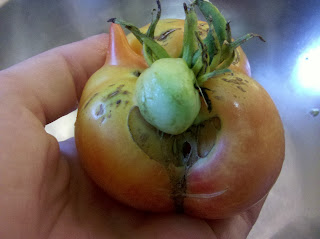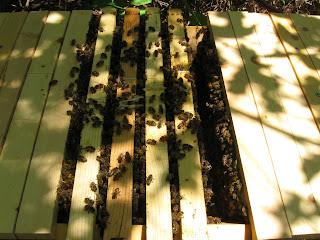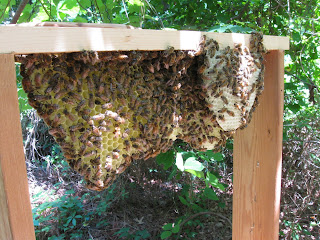After my failed attempt at trying to inspect the hive last time, I decided to get on the internet and order some more beekeeping supplies (smoker, coveralls, gloves). I got suited up and went out to check out the bees to see what was going on. I had thought that maybe something was wrong with them because they had become so defensive since the other 2 inspections I had done. It turns out there didn't seem to be anything wrong afterall. I found the queen on the first bar I pulled out of the hive, so that wasn't the problem. After concluding the inspection I decided that maybe they were being extra defensive because of the sheer population increase or the fact that they now have a ton of stored honey and pollen that they're trying to defend. The inspection went pretty well even though they were still being defensive. Since I was covered from head to toe, I didn't get stung at all this time.
A couple of things that I discovered this time around:
1. As soon as I pulled the roof off of the hive, I saw one SHB scurrying around, but as soon as I saw it, the workers were chasing and trying to sting it. It is the only SHB I saw on my inspection... no infestations or anything, which I thought might have been agitating them.
2. It appears that they are turning hatched brood comb into honey and pollen comb after the bees emerge and the cells are cleaned.
3. Since the bees are currently occupying the middle of the hive, with the follower boards on both sides, they are expanding to the right where the empty bars are. Since they came with only one honey comb (which was placed on the left), and 4 brood combs, as each comb of brood hatched out, the brood moved to the right where the new comb was being made.
4. After pulling out all of the bars that had comb, I found 7 bars with honey and pollen, but 2 of the bars had 2 rows of comb, so it turned out to be about 8 1/2 combs of honey and pollen (some capped, some not).
5. The first natural comb that they built was made into honey, but they added a very clear dividing line and extended it down where brood was then laid (there are pics).
6. I didn't really see any drones while I was inspecting. I guess I wasn't looking too hard for them either though. I'll have to make a point to do that next time.
There's my queen, in the middle of the first bar I pulled out. (Look for the white dot on her thorax)
Newest bar of full, natural comb with brood in it.
Back side of the brood comb in the previous picture.
The empty slot is where the comb in the previous picture belongs.
I love pictures with the bees just spilling out everywhere.
New, unfinished comb that the bees are working on now. I'm not really a fan of how they're putting 2 rows of comb on one bar. It makes inspections much more difficult, but I'm not destroying the comb.
Capped honey comb, previously brood comb. I could feel a big difference in the weight of it when I lifted it out of the hive.
Bees everywhere =)
You can see the workers starting a bee chain on the extended part of comb.
The comb with the division between uncapped honey and brood. The extension on the bottom is the brood.
Back side of the comb in the previous photo. This bar also has 2 rows of comb on it.




















































